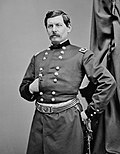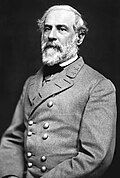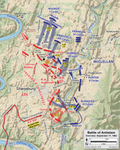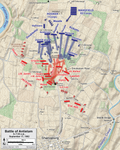Battle of Antietam
| ||||||||||||||||||||||||||||||
The Battle of Antietam was an important battle in the American Civil War. It is also called the Battle of Sharpsburg by South historians.[a] The battle was fought on September 17, 1862, near Sharpsburg, Maryland. It was also considered the bloodiest battle in the Civil war. It was the first major battle in the Civil War that took place in the border states. Both sides hoped a big victory for their side would make a short war.
About 22,720 soldiers were killed, wounded or were missing at Antietam.[3] There has never been another single-day battle in the history of the United States with so many American casualties.[3] However, there have been other battles that lasted for more than one day where more Americans fell.[3] For example, the later Battle of Gettysburg lasted three days and had an estimated 51,000 American casualties.[3]
Background
During the summer of 1862, the hopes of the North that the rebellion could be easily crushed were quickly fading.[4] In July, Major General George B. McClellan's Peninsula Campaign to capture the Southern capital at Richmond, Virginia failed.[4] Near the end of August, the Second Battle of Bull Run was another Confederate victory.[4] The Union armies retreated back to Washington, D.C. only a few miles away.[4] In Tennessee and other western states, Confederate offensives were succeeding.[4] This was causing poor morale in the Union army.[4]
After defeating the Union Army of Virginia at Bull Run, Lee led his Confederate Army of Northern Virginia into Maryland beginning his Maryland Campaign.[5] He had several reasons for attacking the North.[5] First, it was harvest time in the Shenandoah Valley and Lee needed to turn the Union's attention away from his main sources of food for his army.[5] Secondly, he needed European support for the Confederacy. A major win in the North could get the support they needed and also cause the border state of Maryland to secede.[5] It would demoralize the North and possibly get them to negotiate. Lee thought the Union army needed time to rebuild and resupply and moving quickly he could catch them unprepared.[5]
Prelude
In a bold move Lee divided his Army of Northern Virginia into five smaller armies or columns.[6] Three he sent with General "Stonewall" Jackson to attack and hold Harpers Ferry.[6] This way Jackson could control the Shenandoah Valley.[6] He sent his largest corps commanded by Lieutenant General James Longstreet to move towards Sharpsburg, Maryland. Lee wrote Special Order 191 on September 9, which outlined each move by all his columns.[5] In a strange twist of fate, a copy of the order was wrapped around a bundle of cigars and dropped in a field on Best Farm. Union soldiers of the 27th Indiana Regiment found the bundle with the order. It was sent to General McClellan.
McClellan had remained in command of the Army of the Potomac even though he had failed to support Major General John Pope at the Second Battle of Bull Run.[b][9] When Lee entered Maryland, in a rare exception to his usual slowness, McClellan moved more quickly to cut him off.[9] Having knowledge of Lee's plans gave McClellan an opportunity to destroy Lee's army while it was still weakened by Jackson's being sent to Harper's Ferry.[9] McClellan learned of Lee's plan on September 13.[c][9] He boasted "Here is a paper with which if I cannot whip Bobbie Lee, I will be willing to go home."[9] He also sent a telegram to President Lincoln where he wrote, "I have all the plans of the rebels, and will catch them in their own trap if my men are equal to the emergency."[9] But McClellan waited another 18 hours before acting. This delay allowed Lee more time to collect all the elements of his army.[9] As Lee had moved into Maryland, he left detachments to guard two of the passes through South Mountain, Crampton's Gap and Turner's Gap.[12] These were the two most important routes through the 50-mile long South Mountain.[12] Had McClellan moved a little faster, he would have caught Lee's army scattered on the other side of the mountain.[12] At Frederick, Maryland the Union army caught up with Lee and the fighting began on South Mountain.[6] It was a natural formation that separated the Shenandoah and Cumberland Valleys from eastern Maryland. Several battles were fought that day over possession of South Mountain. The Confederates were driven back with a large number of casualties. McClellan could have destroyed Lee's army but he again waited, giving Lee the time to regroup.[6]
The battle
Three days later the two armies, led by Lee and McClellan, met again on September 17, 1862, between Antietam Creek and the town of Sharpsburg, Maryland.[5]
The Battle of Antietam, also called the Battle of Sharpsburg, was not only the bloodiest day of the American Civil War, it was the single bloodiest day in American history.[5] The Confederate troops took up defensive positions behind Antietam Creek. At this point, McClellan decided to attack.
At dawn on September 17, Union soldiers led by Major General Joseph Hooker attacked Lee's troops from their left. As the two armies fought each other, the fighting spread across a local cornfield and around the Dunker Church. The Union troops kept attacking the Confederates at the Sunken Road.[13] They were able to break through the center of the Confederate lines.[13]
Late that afternoon, more Union soldiers, led by Major General Ambrose Burnside, joined the fight.[13] They captured a stone bridge over Antietam Creek and moved towards the Confederate troops' right side.[13] But as Burnside's soldiers attacked, more Confederate soldiers arrived. Confederate Major General A.P. Hill had led his division of soldiers from Harpers Ferry to Antietam. Once Hill's division arrived, they were able to counterattack (fight back against Burnside's soldiers).[13] This was a surprise to the Union troops, and the surprise worked well. The Confederate troops drove Burnside's soldiers back and ended the battle. Even though he had more soldiers, McClellan was not able to destroy Lee's army. Lee was able to shift his troops to meet each of McClellan's attacks. McClellan also did not call up his many reserve forces (soldiers on standby) which could have helped build on the Union's successes.
Aftermath
The next day both armies collected their wounded and buried their dead soldiers.[14] Then Lee withdrew his army back to Virginia.[14] McClellan did not go after Lee which frustrated President Lincoln.[13] Militarily the battle was a draw. But because Lee's forces retreated from Maryland, Lincoln claimed victory.[13] He used the occasion to issue the Emancipation Proclamation.[13]
Battle Of Antietam Media
Dead horse belonging to a Confederate colonel who was also killed, near the East Woods.[15]
Dead Confederate soldiers from Starke's Louisiana Brigade, on the Hagerstown Turnpike, north of the Dunker Church.Photograph by Alexander Gardner
Notes
- ↑ Many Civil War battles have two names.[1] Federal sources named battles after the nearest creek or river.[1] Confederates named a battle after the nearest town.[1] For example, the first and second battles of Bull Run, also known as Manassas, were named for Bull Run Creek, near the town of Manassas, Virginia.[2]
- ↑ McClellan was considered a great organizer but did not prove to be a great battlefield commander.[7] He was too cautious and generally moved his army at a snail's pace.[7] His delays usually gave Confederate Generals ample time to retreat or regroup.[8]
- ↑ At the time he received a copy of Lee's order, McClellan was meeting with local citizens.[10] Among them was a Confederate sympathizer. He didn't know what the message said, but by McClellan's reaction he knew the Union general had learned something significant.[10] He rode off to report this news to a Confederate officer, who passed the information on to Lee.[10] Lee was surprised when McClellan moved quicker than usual but did not learn of the lost order until sometime after the Maryland Campaign.[11]
References
- ↑ 1.0 1.1 1.2 Shon Powers, A Buff Looks at the American Civil War (Bloomington, IN: AuthorHouse, 2011), p. 501
- ↑ "Remembering the First Battle of Bull Run (Manassas)". History in the Headlines. A&E Television Networks, LLC. 21 July 2011. Retrieved November 18, 2016.
- ↑ 3.0 3.1 3.2 3.3 "Casualties of Battle". Antietam National Battlefield, Maryland. National Park Service, U.S. Department of the Interior. Retrieved November 18, 2016.
- ↑ 4.0 4.1 4.2 4.3 4.4 4.5 "The Maryland Campaign of 1862". Civil War Trust. Retrieved November 18, 2016.[dead link]
- ↑ 5.0 5.1 5.2 5.3 5.4 5.5 5.6 5.7 "Battle Of Antietam". HistoryNET. Retrieved November 18, 2016.
- ↑ 6.0 6.1 6.2 6.3 6.4 "Maryland Campaign & Battles of the Civil War". American History. Legends of America. Retrieved November 18, 2016.
- ↑ 7.0 7.1 "Why Civil War Gen. George McClellan wasn't actually a failure". 5 March 2012. Archived from the original on 3 August 2020. Retrieved November 18, 2016.
- ↑ "George B. McClellan". Civil War Trust. Retrieved November 18, 2016.
- ↑ 9.0 9.1 9.2 9.3 9.4 9.5 9.6 "George Brinton McClellan". National Park Service, U.S. Department of the Interior. Retrieved 1 July 2016.
- ↑ 10.0 10.1 10.2 Phil Leigh (November 18, 2016). "Lee's Lost Order". The New York Times. Retrieved 2 July 2016.
- ↑ "An Invitation to Battle: Special Orders 191". Monocacy National Battlefield Maryland. National Park Service, U.S. Department of the interior. Retrieved November 18, 2016.
- ↑ 12.0 12.1 12.2 "1862 North and South clash at the Battle of South Mountain". This Day in History. A&E Television Networks, LLC. Retrieved November 18, 2016.
- ↑ 13.0 13.1 13.2 13.3 13.4 13.5 13.6 13.7 "Antietam". Civil War Trust. Retrieved November 18, 2016.
- ↑ 14.0 14.1 "Battle of Antietam" (PDF). National Park Service, U.S. Department of the Interior. Retrieved November 18, 2016.
- ↑ Frassanito 1978, p. 122.
Other websites
- Battle of Antietam Archived 2007-12-12 at the Wayback Machine Staff ride guide, Center of Military History, United States Army.
- Animated History of The Battle of Antietam Archived 2008-05-12 at the Wayback Machine
- Lincoln and Lee at Antietam Archived 2006-03-13 at the Wayback Machine
- Antietam National Battlefield Park
- Antietam on the Web
- USS Antietam Archived 2005-12-02 at the Wayback Machine
- History of Antietam National Cemetery :including a descriptive list of all the loyal soldiers buried therein {published 1869}
- Brotherswar.com The Battle of Antietam Archived 2006-11-14 at the Wayback Machine
- Battle of Antietam: Two Great American Armies Engage in Combat article by Ted Alexander










